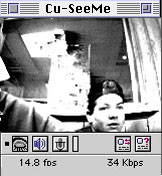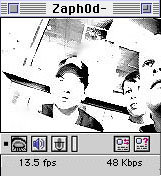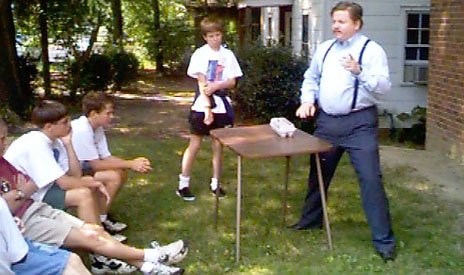|
July 9, 1997 The third day of Shodor's Internet Explorers Club concentrated on Internet chat client software and science observation. The Internet Explorer's succesfully completed the objectives set forth by the Shodor staff. The class began with an introduction to domain names. The students quickly mastered this task and went on to learn about Internet Positions (IP) and different types of syntax for search engines. Then Shodor intern Alton Patrick taught the class about fractals and Java. "I've been here less than a year...majoring in computer science and math," explained Alton Patrick. "They teach you how to think like a computer; it's another way of teaching," Alton explains his job at Shodor. Alton continued to tell the students that one of his job specifications was an understanding of Common Gateway Interface (CGI) and Java. "Java is something where all of the calculations are done locally on your computer."
Next Anne Thissen, another of Shodor's interns, explained to the class the different types of Internet chat client softwares available. "Talk is a way for two people to communicate over the Internet," explained Anne. After they setup the program Talk they were amazed at what the Internet had to offer. "This is cool!," said Nicole, one of the young Internet Explorers attending Shodor's classes. After the introduction to Talk chat software, the students moved into the area of Internet etiquette with an understanding of bandwidth. Soon the Internet Explorers were using another Internet chat client in which multiple persons could access one another over the internet. This program, called Global Chat, is just one of several applications the students would be learning. "It was exciting using Global talk," said Brian, an IEC student. The next endeavor they explored was a video conference system called CU-SeeMe. While using this software Dr. Robert Panoff, Bob1, explained to the class about feedback and how the cameras received the images. After they finished with the communications portion of the Internet Explorers Club, Danny Grasse introduced the students to whiteboards. He explained to them how whiteboards could be used to allow many users to interact with the same program and see changes that other people make. He used a program called Wyndhaven to show them how interaction with whiteboards are used over the Internet. Next Bob1 taught Shodor's IEC students about observations in science. He took them outside and led them in an observation experiment. He had the students test an egg in different ways to see if the eggs were one of four things: full of air, full of water, hard boiled, or raw. He then showed an egg to one of the students in the class to see if this particular student could tell what kind of an egg the egg was. "Wade has the most famous ear on the Internet," joked Wade's fellow classmates after Wade listened to Bob1 shake the egg. Eventually, they all decided that the only way that they could tell what the eggs contained was to crack them open. Bob1 cracked the first egg to reveal that the egg wasn't raw or hard boiled--it was empty. The students, amazed, were more excited then ever and ready to return again to continue their exploration of the internet.
The third day, facing new challenges and new opportunities, proved to be as much a victory as the second. The day was spent on the computers and outside, providing the students with a true and in-depth knowledge of Internet communication, whiteboards, and observation . Upon leaving the Foundation, students' understood and appreciated their improved understanding of the science and the Internet.
Last Update: June 14, 1999 Please direct questions and comments about this page to WebMaster@shodor.org © Copyright 1998 The Shodor Education Foundation, Inc. |




